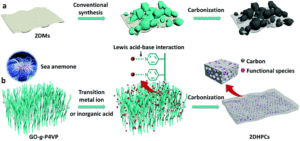What do sea anemones and two-dimensional (2D) carbon-based materials have in common? Sea anemones are predatory marine animals and 2D materials are often used for applications in catalysis and energy storage. Most would assume there is little in common between this obscure pairing, however, researchers in China took inspiration from the unique anatomy of sea anemones (particularly their tentacles that can trap and capture prey) for their design of new 2D hybrid porous carbon materials.
Hybrid 2D carbon-based materials combine the desirable properties of 2D porous carbon materials (large surface area and good electronic conductivity) with additional functional components (e.g. metal ions or inorganic acids), which can enhance and control the properties of the material. However, the construction of hybrid materials is often limited by poor dispersion of the functional component on the carbon structure, as the functional precursors tend to aggregate on the surface, and thus diminish the desired properties for the material. To overcome this undesirable aggregation, the researchers turned to their sea-anemone, bio-inspired strategy, where they used carbon-based molecular brushes as building blocks to imitate tentacles, allowing functional precursors to be trapped within the brush network make the hybrid materials (Figure 1).

Figure 1. (a) A conventional strategy for the construction of 2D hybrid materials, where the functional components are shown to aggregate on the surface. (b) The sea-anemone inspired approach by the researchers, starting from a carbon molecular brush network that traps the functional component (Lewis acids), leading to 2D hybrid materials after carbonization.
The researchers used poly(4-vinylpyridine)-grafted-graphene oxide (GO-g-P4VP) as the molecular brush substrate and carbon source for the creation of their 2D hybrid materials. They created the substrate by covalently grafting a thin layer of poly(4-vinylpyridine) (P4VP) from a single-layer graphene oxide (GO) surface and used microscopy techniques to characterise the resulting materials, where various protuberances were observed on the GO sheets to signify the brushes. Next, the GO-g-P4VP brushes were subjected to various Lewis acids (Co2+ ions, B or P; using either cobalt nitrate, boric acids or phytic acids, respectively). The researchers observed spontaneous chemisorption and immobilisation of the Lewis acids within the brush structure, due to the strong interaction with the Lewis basic pyridine groups of the P4VP chains. Lastly, the material was then carbonized at 800 °C to produce the 2D hybrid porous carbon materials (2DHPCs), functionalised with Co (2DHPC-Co), B (2DHPC-B) or P species (2DHPC-P).
The new 2DHPCs were characterised using microscopy techniques and X-ray diffraction, which confirmed 2D morphologies of the materials, uniform distribution of the Lewis acid species and porous structures. The researchers then demonstrated the potential of these high-porosity and functionalised materials by testing them in applications as oxygen evolution reaction (OER) electrocatalysts or as sulfur hosts within Li-S batteries, where in both cases, the 2DHPCs excelled compared to other graphene-based materials. Ultimately, the researchers have demonstrated that their sea-anemone inspired strategy allows for the successful construction of high performance 2D hybrid materials, and could be translated for the design of promising new materials for future energy conversion and storage applications.
To find out more, please read:
Xidong Lin, Zelin Wang, Ruliang Liu, Shaohong Liu,* Kunyi Leng, He Lou, Yang Du, Bingna Zheng, Ruowen Fu and Dingcai Wu*
Chem. Commun., 2021, 57, 1446–1449
About the blogger:
 Dr. Samantha Apps recently finished her post as a Postdoctoral Research Associate in the Lu Lab at the University of Minnesota, USA, and obtained her PhD in 2019 from Imperial College London, UK. She has spent the last few years, both in her PhD and postdoc, researching synthetic nitrogen fixation and transition metal complexes that can activate and functionalise dinitrogen. Outside of the lab, you’ll likely find her baking at home, where her years of synthetic lab training has sparked a passion in kitchen chemistry too.
Dr. Samantha Apps recently finished her post as a Postdoctoral Research Associate in the Lu Lab at the University of Minnesota, USA, and obtained her PhD in 2019 from Imperial College London, UK. She has spent the last few years, both in her PhD and postdoc, researching synthetic nitrogen fixation and transition metal complexes that can activate and functionalise dinitrogen. Outside of the lab, you’ll likely find her baking at home, where her years of synthetic lab training has sparked a passion in kitchen chemistry too.










